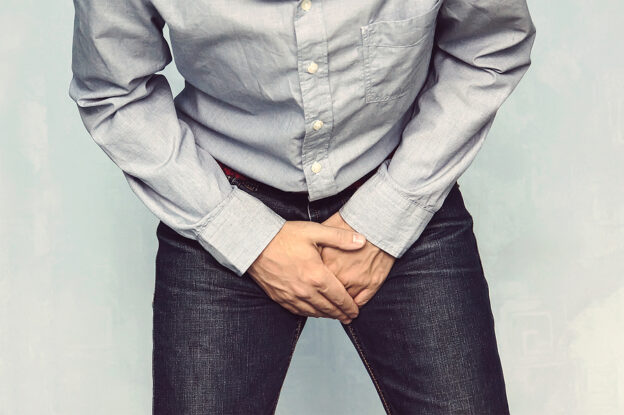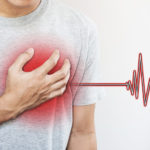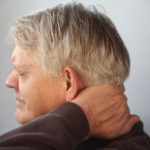By David Blyweiss, M.D., Advanced Natural Wellness
January 14, 2022
Isn’t it funny how you can feel the need to urinate when you’re driving home, but you don’t have any problem holding it? You’re fine. But the second you pull into your driveway the urge gets really bad. And then, when you put your key in the door, the need to pee suddenly becomes urgent. You can barely hold it in.
What just happened in the last five seconds? It’s almost as if, when you placed the key into the lock, it unlocked your bladder. And now you’re rushing as fast as you can to get to the toilet.
There’s actually a name for this. It’s called “latchkey urgency.” Or, if you actually experience leakage, it would be “latchkey incontinence.”
But rushing to the toilet, whether because of a latchkey urge, overactive bladder or urinary incontinence, can be dangerous, especially as you age. It can make you about twice as likely to take a fall.
And oddly enough, it’s not rushing to the bathroom that causes this increased risk.
You see, as we get older our gait tends to become slower and narrower. We take shorter strides and walk with less speed. This might sound stabilizing but, in reality, it reduces your base of support. So you actually end up with less control than more. And that reduces balance and stability.
Open your arteries, improve blood flow for a new health miracle...
Did you know your circulatory system has over 60,000 miles of arteries, veins and other blood vessels, if stretched end to end?
But as you age, your blood vessels undergo changes, which may cause them to stiffen, thicken and get clogged.
GOOD NEWS! Doctors have now identified a “Miracle Molecule” inside your arteries that helps OPEN your arteries and IMPROVE blood flow.
It’s what Dr. Valentin Fuster calls it, "One of the most important discoveries in the history of cardiovascular medicine."To you, that means...
- Healthy blood pressure
- Sharper mind and memory
- Skyrocketing energy and muscular strength
- Increased pleasure and passion in the bedroom
- Improved circulation to every cell and organ in your body
Go here to discover a new natural way to significantly boost the levels of this miracle molecule in YOUR body NOW!
When you need to pee really bad, it gets even worse. It’s like walking while performing a distracting mental task. And that’s what’s associated with the increased risk of falling and injuries.
So you have two things going on here. A lack of bladder control combined with stability issues.
Get Your Bladder Under Control
Overactive bladder (OAB) is a common condition among older adults. It causes a sudden urge to urinate. And if you have overactive bladder, you probably urinate quite often… eight or more times a day. Some people also experience embarrassing leakage, or incontinence.
If this sounds like you, it makes sense to hit the restroom every hour or so when you’re at home, and definitely before you get into your car. But at the same time, you need to find ways to gain control of your symptoms.
A weak urethra or pelvic muscles may be part of the problem. In fact, the American Urological Association recommends pelvic floor muscle training as a first line of treatment for OAB. In that case Kegel exercises are called for. They strengthen the muscles that help control the urethra.
Women know what I’m talking about. But they work equally as well for men. Simply contract your pelvic floor muscles (the same muscles you use to stop your urine stream) for a count of 10, then relax the muscles for another count of 10. Repeat the exercise 8 to 12 times, 3 times a day. stop or slow down the flow of urine.
There are also some other things that can help relieve OAB symptoms.
Are You Suffering From...
- Love handles and a pot belly
- Romance that isn't what it used to
- Forgetfulness and inattention
- Low (or no) strength and endurance
- A sex drive that's shifted into neutral...or worse
If so...you may have Mature Male Burnout. Click here to discover more about this unique condition and what you can do about it.
Regulate your liquid consumption. It’s easy to chug down 12 or 20 ounces of liquid at a time when you’re thirsty. And that’s a lot for your bladder to process.
If you want to avoid putting too much burden on your bladder at once, try drinking a steady 4 to 5 ounces of liquid each hour.
Caffeine will kick your bladder into high gear and trigger OAB symptoms. Plus, Coffee, tea, energy drinks and soda all have diuretic tendencies that are guaranteed to keep you running to the toilet to relieve yourself.
If you have bladder control issues, I suggest going caffeine free. And remember, a cup of tea has the same amount of caffeine as a cup of instant coffee. So tea is not going to be a safer choice when it comes to bladder control.
Certain foods and beverages act as bladder irritants. Fruits and juices high in acid, like oranges, lemons, limes, tomatoes and grapefruits can all irritate the bladder. Spicy foods are another bladder irritant. Carbonated drinks, artificial sweeteners and alcoholic beverages also fall into this category. Any of these items can irritate or inflame the bladder, aggravating symptoms of OAB. So it’s a good idea to limit your intake of them.
Implementing these changes to get your bladder under control is a great first step to reducing the urgent need to pee. But you will also want to take steps to lower your chances of taking a fall.
Improve Your Strength and Balance
There is no better anecdote for improved muscle and bone strength than good old-fashioned exercise. Specifically, resistance exercise.
And 121 randomized controlled trials prove it. They all show that older people who participate in resistance training get stronger, walk and climb stairs better and are able to get up and down from their chair more quickly.
In fact, one of those studies involved people from 90 to 99 years of age. With just 8 weeks of high-intensity resistance training they increased their muscle strength by an astounding 174%, and their gait speed by 48%.
That’s amazing! They nearly doubled their strength and increased gait speed by half in just two months!
Chair squats, wall push-ups, and supported lunge exercises are some of my favorite kinds of resistance exercise. They use your own body weight to engage muscles and boost muscle mass. Plus, they’re movements that strengthen the muscles your body uses every single day. If you prefer, you can buy “resistance bands” like I just did from Amazon. They hook on your door and by pulling on them you will gradually increase your muscle strength.
It only takes about a half-hour a day, three days a week to get your resistance training in. I recommend performing the activity for a count of 10 and then taking a short one-to- two-minute break. Then perform two more sets of ten with another break between them. As you gain strength, increase the count and reduce your break time.
On the days you don’t perform your resistance training, you should still take the time to go on a nice, long walk.
If you have any concerns at all don’t hesitate to talk to your doctor first. He will be the first to tell you that simple, easy exercises like these are crucial when it comes to your health.
SOURCES:
Gibson W, Jones A, Hunter K, Wagg A. Urinary urgency acts as a source of divided attention leading to changes in gait in older adults with overactive bladder. PLoS One. 2021 Oct 4;16(10):e0257506.
Arvin M, Mazaheri M, Hoozemans MJM, Pijnappels M, Burger BJ, Verschueren SMP, van Dieën JH. Effects of narrow base gait on mediolateral balance control in young and older adults. J Biomech. 2016 May 3;49(7):1264-1267.
Diagnosis and Treatment of Overactive Bladder (Non-Neurogenic) in Adults: AUA/SUFU Guideline. Copyright © 2012 American Urological Association Education and Research, Inc.®
Liu C-j, Latham NK. Progressive resistance strength training for improving physical function in older adults. Cochrane Database of Systematic Reviews 2009, Issue 3. Art. No.: CD002759.
Fiatarone MA, Marks EC, Ryan ND, Meredith CN, Lipsitz LA, Evans WJ. High-intensity strength training in nonagenarians. Effects on skeletal muscle. JAMA. 1990 Jun 13;263(22):3029-34.







